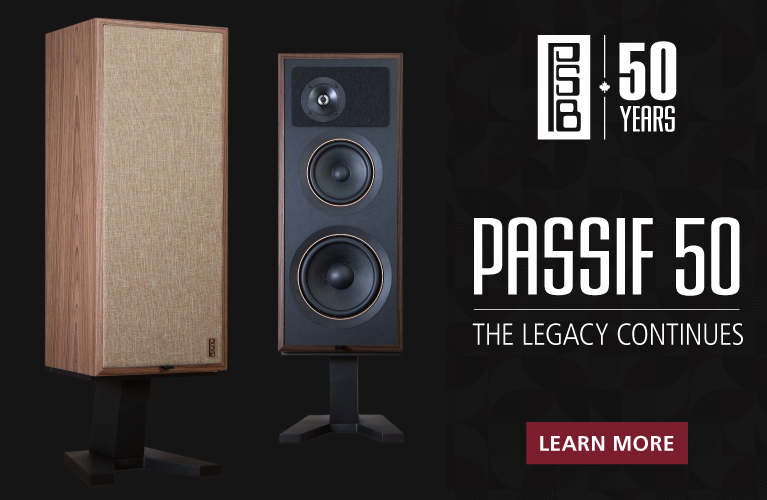Note: for the full suite of measurements from the SoundStage! Audio-Electronics Lab, click here.
 I might as well admit it at the outset: I’m a Bryston fanboy. One of Canada’s hi-fi darlings, Bryston is known for making sturdy, high-powered amplifiers that last almost forever. How long is forever? Well, all Bryston amps are covered by an industry-leading 20-year warranty. The company’s legendary 4B power amplifier has been in production in various iterations since the 1970s.
I might as well admit it at the outset: I’m a Bryston fanboy. One of Canada’s hi-fi darlings, Bryston is known for making sturdy, high-powered amplifiers that last almost forever. How long is forever? Well, all Bryston amps are covered by an industry-leading 20-year warranty. The company’s legendary 4B power amplifier has been in production in various iterations since the 1970s.
Bryston’s digital components, which comprise CD players, DACs, streamers, and A/V processors, are covered by a five-year warranty—impressive for products in which the underlying technology is evolving rapidly. They have earned as much praise as the company’s amplifiers and preamplifiers.
When I started this review, my reference system included four Bryston components: the 3B SST2 power amplifier, BP-25 preamplifier with MPS-1 outboard power supply, BDA-2 digital-to-analog converter, and BDP-1 streamer (all now discontinued).
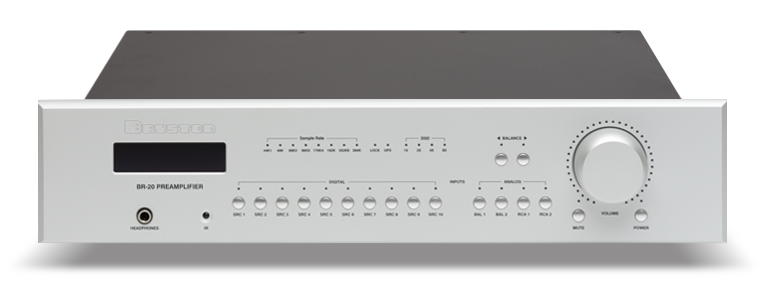
When an opportunity arose to review Bryston’s BR-20 streaming DAC–preamp, I jumped at the chance. But while I was excited about this project, I was also a bit leery.
Leery, because digital technology is changing so rapidly. Many audio manufacturers, Bryston included, separate their digital and analog lineups. This allows owners to update a streamer or DAC separately from the amplifier and preamplifier. Some brands specialize in analog gear, others in digital components. Not many excel in both—but Bryston does.
Excited, because the BR-20 is a clean-sheet design meant to honor the memory of former Bryston president Brian Russell—hence the model number. Development was nearly complete when Brian passed away unexpectedly in 2020, at the age of 68. On its website, Bryston describes the BR-20 as its “most exquisite representation of musicality ever . . . a fitting tribute to our late dear friend and colleague Brian Russell.”
Priced at $6795 (all prices in USD), the BR-20 incorporates a high-resolution DAC, a streamer, and a preamplifier in a single chassis. The BR-20 is also available with an HDMI board, which provides four inputs and one output; that configuration costs $7500. Could this all-in-one preamp-DAC-streamer outclass separate components, like my BDA-2 DAC, BDP-1 streamer, and BP-25 preamp? That’s what I set out to determine.
Description
Weighing only 12 pounds, the BR-20 is surprisingly lightweight, especially for a Bryston component. The BR-20 measures 4.6″H × 13″D without faceplate, and is available with a 17″ or 19″ faceplate. My review sample had a 19″ silver faceplate. In addition to the standard black and silver faceplates, Bryston components are now available with champagne, white, and gun-metal gray faceplates. There is no extra charge for these optional finishes.
As with all Bryston components, there’s no flash or sizzle in the BR-20’s visual design, which matches the aesthetic of my mostly Bryston system. The anodized faceplate has the same smooth texture as other recent Bryston components. I prefer the brushed anodized faceplates of the older models.
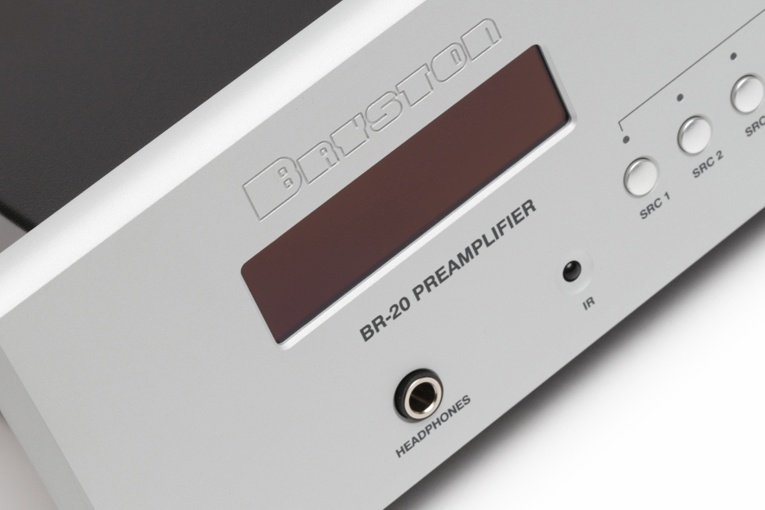
On the left side of the front panel is a 1″ × 3″ context-sensitive monochrome LCD that shows volume level, input name, and track metadata, and below it is a 1/4″ single-ended output jack for the BR-20’s dedicated headphone amplifier. There are two rows of pushbuttons across the middle of the front panel for selecting inputs: ten for digital sources and four for analog sources. On the far right is a large volume dial surrounded by white LEDs that show the volume setting. Below the volume knob are play/pause and mute buttons. To its left are two buttons for adjusting channel balance. A row of LEDs above the input buttons indicates the sample rate of the DAC when using a digital source.
The LCD shows either two rows of text or, more to my liking, an easy-to-see volume readout that takes up the full height and width of the display. There are many options for LED and display brightness, and even LED colors—users can choose between green and blue. The display and LEDs can be dimmed or turned off, which is great for late-night listening sessions.
A quick look at the back is enough to tell you that the BR-20 can be configured to suit many different system types and use cases. On the left side are two sets each of balanced (XLR female) and single-ended (RCA) line-level analog input jacks, and below these are two sets of balanced (XLR male) line-level outputs. To the right are the digital inputs: two AES/EBU (XLR female), two coaxial S/PDIF (RCA), two optical S/PDIF (TosLink), and asynchronous USB audio (Type B). Moving further right, we find two 12V trigger outputs (3.5mm) for powering up other components when the BR-20 is turned on; RS-232, USB, and SMC ethernet ports for controlling the BR-20 over a network; and a 12V trigger input for powering the BR-20 up and down from 12V outputs on other components. Above those connectors is an ethernet port for connecting the BR-20 to a home network, as well as four USB accessory 3.0 ports (Type A) for connecting external drives. With the optional HDMI board installed, the HDMI input and output ports are arrayed across the top center. In addition to receiving PCM audio from components like media players, the HDMI board can receive DSD audio from an SACD player with HDMI output. The board can switch and pass through 4K HDR video, but does not support HDMI ARC (Audio Return Channel).
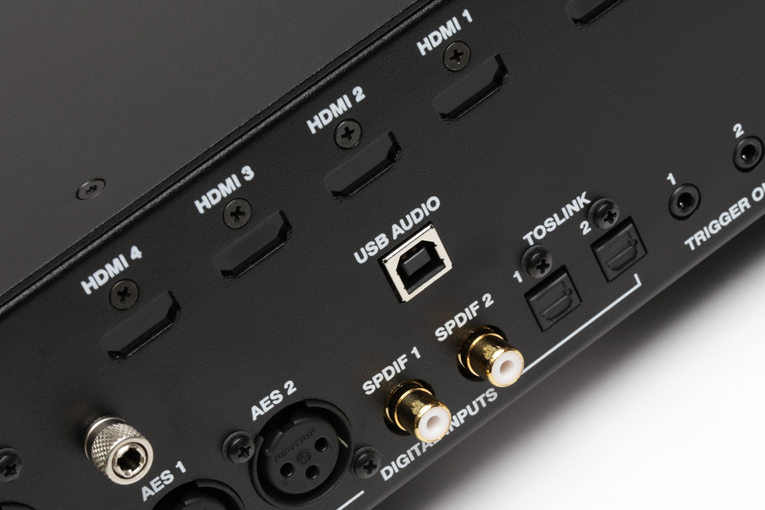
According to Bryston president James Tanner, “most BR-20s [now] go out with the HDMI factory-installed,” but early on, supply-chain issues limited availability of this option. People who purchased a BR-20 without the HDMI board can add one later for $850. It must be installed by a technician. Bryston also offers a user-installable MM phono stage for $1000. My review sample did not have the HDMI board or phono stage installed.
Under the hood is a DAC derived from Bryston’s BDA-3 external DAC, and a streamer based on a Raspberry Pi 4 single-board computer. Maximum resolution of the BR-20’s internal DAC is 24-bit/96kHz via TosLink; 24/192 via coaxial S/PDIF, AES, and HDMI; and 32/384 via USB and the streamer module. The BR-20 supports DSD, in both native and DoP (DSD over PCM) formats. Maximum resolution is DSD64 via HDMI, DSD256 via USB, and DSD128 via the streamer module.
The BR-20 has separate power supplies for the digital and analog sections. Relay switching is used for all inputs, and the analog section employs fully balanced class-A circuitry. The headphone output is not pulled down from the main output stage; it employs its own dedicated op amp. The company claims it’s “Bryston’s most powerful onboard headphone amplifier ever,” and that it “delivers startling clarity and dynamic capability second only to Bryston’s legendary BHA-1 outboard headphone amplifier.”
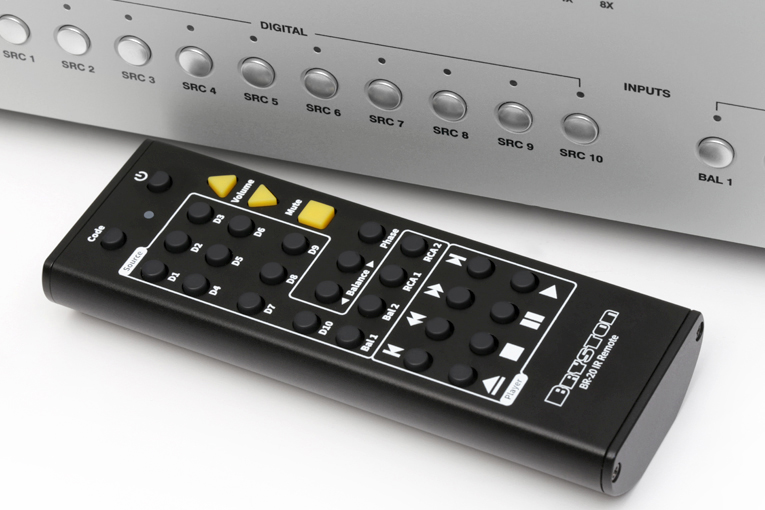
Included with the BR-20 is Bryston’s BR-4 remote control, a lightweight but solid aluminum unit without backlighting. Functions include power, volume, mute, source selection, balance, and phase. There are also transport controls for use with a Bryston CD player.
Many configuration tasks, such as network reset and LED brightness, must be done using the front-panel screen, arrow keys, and volume knob (which can be pushed so that it acts like an Enter key). I found the volume dial/button quite jumpy in its response, which made it frustrating to navigate some of the menus. Fortunately, setup is usually a one-and-done procedure.
For day-to-day use, the BR-20 serves up a web interface called “Manic Moose,” which can be accessed from a PC, smartphone, or tablet. Manic Moose can be used for controlling playback from USB, network drives, and supported streaming services—including Tidal and Qobuz. Users can activate an AirPlay emulator called Shairport Sync; this enables CD-resolution streaming from Apple devices. I found Manic Moose a little awkward, but Tanner says Bryston is working on a new interface that will replace Manic Moose. It will probably be released in the summer of 2023. However, the BR-20 has received Roon Ready certification. “A lot of our customers . . . use Roon,” Tanner stated in an email exchange, “[as] it bypasses many of the issues people have had with MM in the past.” I used Roon rather than Manic Moose for most of my testing.
System and setup
As mentioned in the introduction, my basement stereo system includes a Bryston BDP-1 streamer, BDA-2 DAC, BP-25 preamp with MPS-1 power supply, and 3B SST2 power amplifier, which is rated at 150Wpc into 8 ohms or 250Wpc into 4 ohms. The electronics are plugged into a Torus RM 15+ power isolation transformer, which is connected to a dedicated power circuit with a home-run ground to our electrical panel using 10 AWG stranded copper.

The 3B SST2 amplifier powers a pair of Dynaudio Contour S 5.4 floorstanding speakers. These are big speakers, standing almost 5′ tall and weighing over 100 pounds each. Now discontinued, the Contour S 5.4 is a three-way, four-driver, rear-ported design, employing two 8″ magnesium silicate polymer (MSP) woofers, a 6″ MSP midrange driver, and Dynaudio’s Esotar2 1.1″ silk-dome tweeter. Each speaker is supported by four IsoAcoustics Gaia II isolation feet, which sit on matching platforms that are spiked through the carpet to the concrete floor below.
To address the question I posed in the introduction (“Could this all-in-one preamp-DAC-streamer outclass separate components?”), I split my review into three sections. First, I used the BR-20 as a preamp only, comparing it to my BP-25 preamp. Next, I evaluated the BR-20 as a DAC-preamp, taking out my BDA-2 DAC and using the BR-20’s internal DAC. Finally, on learning that the BR-20 had received Roon Ready certification, I used the BR-20’s internal streamer, so that the Bryston all-rounder functioned as a streaming DAC-preamp.
Round 1: Preamp only
For my first round of listening, I connected my BDA-2 to one of the BR-20’s balanced inputs, and compared it with the sound of the BDA-2 playing through my BP-25 preamp. My BDP-1 digital player was connected to one of the BDA-2’s AES/EBU digital inputs.
After running the system in for a few hours, I sat down for some serious listening, beginning with “The Race,” by Yello, from the 2005 remastered version of the band’s album Flag (16-bit/44.1kHz FLAC, Polydor / Tidal). This is a strange, dynamic, and highly percussive tune, with a mix that constantly shifts the emphasis between the various elements. There’s a raspy horn section at the back, vocals that span the whole width of the soundstage, and race cars that pan from left to right and back again. I remember hearing this song in Bryston’s huge demo room at the Montreal Audiofest back in the pre-pandemic era, when James Tanner used it to demonstrate a system comprising Bryston’s Model T Active floorstanding speakers, BAX-1 digital crossover, and three power amplifiers—one for each of the three frequency bands reproduced by the speakers.
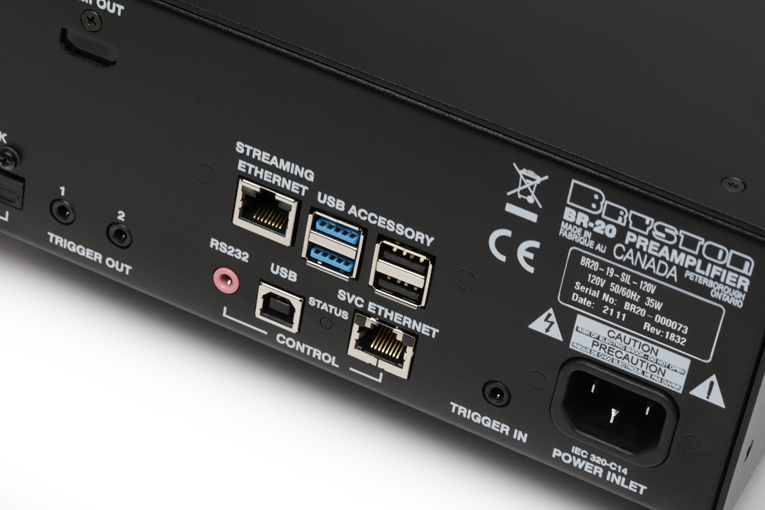
Hearing this track at home, with the BR-20 rather than my BP-25 performing preamp duties, I experienced the most transparent sound I’ve heard from my core system. Even more remarkable was the added weight the BR-20 gave to vocals and instruments. “The Race” is one of those tracks that can show how wide a soundstage your system can throw. At the same time, there are lots of percussive sounds that need to be firmly anchored in the mix in order to establish the groove on which the whole track is built. The BR-20 sorted out this chaos with consummate ease.
On London Grammar’s “Hey Now,” from the 2013 album If You Wait (24/44.1 MQA, Columbia / Tidal), there was more space around Hannah Reid’s haunting vocals than I’d ever heard on this recording. The BR-20 rendered the deep, pounding synth notes with greater ease, control, and extension than my BP-25. Played through the BR-20, highs were smoother and more extended than they were through the BP-25. There was more “air.” I could hear more of the acoustic character of the recording venue.
I’m a Canuck, and my system has several Canadian components, so it seemed fitting to stream the Tragically Hip’s “Machine,” from their final album, Man Machine Poem (16/44.1 FLAC, Universal Music Canada / Tidal). “Machine” isn’t the most impressive tune from the Hip’s vast catalog, but Man Machine Poem is a great album. While it’s a studio recording, it has loads of mood and atmosphere. I chose this track because it’s a great test for soundstage depth. Rob Baker’s smooth guitar is located far behind the band. The drums are lively, punchy, and nicely anchored, with the kick drum having a very prominent attack. The BR-20 easily unraveled the many layers of this track.
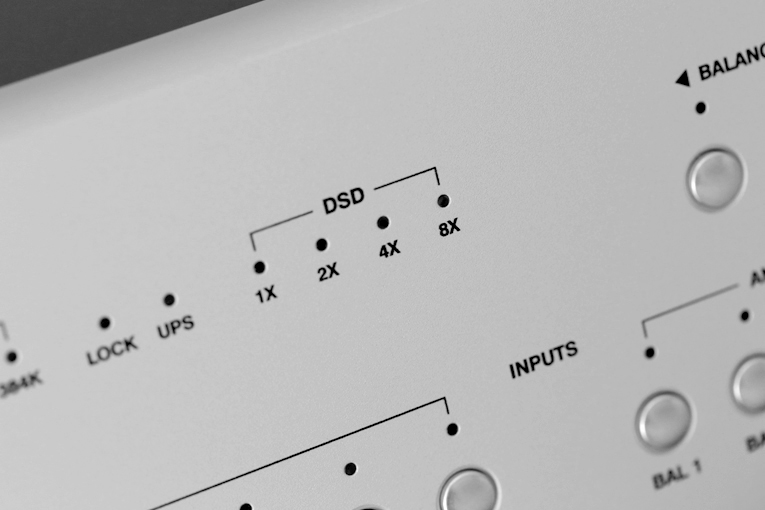
As I re-read my listening notes, I recalled how moving it was to hear my favorite band play the last track of its last album, which was released in 2016, a year before the untimely death of Gord Downie, the Hip’s sublimely talented front man. “It’s like slipping into your most comfortable hoodie or runners or a La-Z-Boy recliner,” I wrote. “Everything in the music was dialed-in just the way I like it.” Compared to my BP-25, the BR-20 delivered more detail and better soundstaging. But for me, its greatest strength was the ability to cut straight to the heart of the musical performance; the BR-20’s virtues seemed to be more than simply sonic.
Round 2: Using the BR-20’s built-in DAC
For my second round of listening, I disconnected my BDA-2 DAC and connected my BDP-1 streamer directly to one of the BR-20’s AES/EBU inputs.
Much of my listening is done in the evenings when the kids are asleep. My basement listening room is somewhat soundproofed, so I can enjoy levels of about 85dB (C-weighted, slow) at my listening position 10′ away from the speakers—this is what most people would consider a medium volume. With the BR-20 now handling D-to-A conversion and preamplification, my system showed new macrodynamic capabilities—even at low volume settings. Usually, one thinks of large-scale dynamics as being most noticeable when the volume is cranked up—when you’re pushing your system a bit. But a component that improves dynamics at low-to-medium volume settings is a valuable addition for times when you can’t listen loudly. The BR-20 has this ability, thanks to the ultra-low distortion of its preamp and DAC sections.
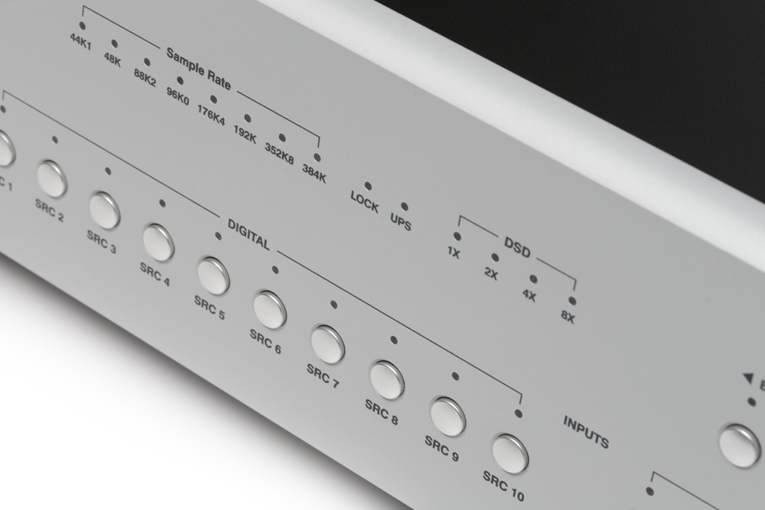
With the BR-20’s internal DAC now handling D-to-A conversion, the performance improved several notches. The BR-20 did justice to every song I played, no matter the volume setting, the musical genre, or quality of the source material. Midrange detail and tonal quality improved dramatically. There was more detail from each recording, with those details more neatly placed in the overall mix. That inspired me to dig into albums from my youth—the likes of Our Lady Peace, Dave Matthews Band, Daft Punk, and of course, more of The Tragically Hip.
One of those albums was Natalie Merchant’s Live in Concert (24/44.1 MQA, Elektra Records / Tidal). On her cover of Neil Young’s “After the Gold Rush,” Merchant’s vocals sounded so full and powerful at times that I was worried that my room acoustics would be overloaded—but that didn’t happen. It was the same story with the short guitar solo that comes in at 1:50. The highly reverberant character of this passage did not overload my room, even when my brain was telling me I was approaching the point where my room acoustics would cause an obvious midrange emphasis. But that never happened. It dawned on me that perhaps the limitations of my room weren’t an issue. Maybe the reason I wasn’t hearing midrange emphasis was that the BR-20’s DAC and preamp sections were reproducing the track with less distortion than my own BP-25/BDA-2 combo. Given the high (and deserved) acclaim those products have received, that’s no mean feat.
Round 3: Going all-in with the BR-20
A few months after the BR-20 arrived at my home, Bryston pushed out a firmware update that enabled Roon Ready mode. Switching out my BDP-1 and using the BR-20’s built-in streamer yielded improvements similar to those I had heard in earlier rounds: greater bass detail and more lifelike presentation, especially on live recordings.
Ben Harper and Charlie Musselwhite (“Memphis Charlie”) have joined forces on two excellent blues albums: Grammy-winning Get Up! from 2013, and No Mercy in This Land (Deluxe Edition) from 2018 (16/44.1 FLAC, Anti- Epitaph / Tidal). A standout from these two great albums is the live version of the title track from No Mercy, which is found only on the deluxe edition. Recorded at the Machine Shop in Atlantic City, this tune is a great late-night listen if you like slow, smoky blues numbers. There’s abundant bass with excellent depth and impact. Musselwhite’s harmonica sits back on the stage and off to the left, with Harper’s guitar given lots of space off to the right. The room size is easy to detect and plays a big part in this recording. Through the BR-20, sibilants on Harper’s vocals were as perfect as I’ve ever heard them, with sharp detail and absolutely zero etch. The brushwork on the drums was likewise excellent.
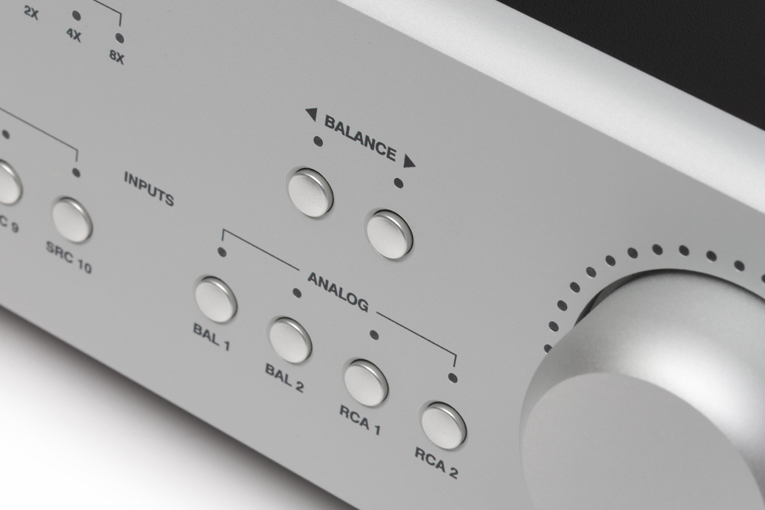
Along with all this newfound top-to-bottom detail, the BR-20 delivered a truly relaxing sound while improving the dynamics and drive I have always enjoyed from my Bryston-Dynaudio setup. Here’s the thing: I would not have referred to my system as “relaxing” before hearing the BR-20. With the BR-20 serving as preamp, DAC, and streamer, the sound was more detailed but less etched than it was through the BP-25/BDA-2/BDP-1 combination, with more space separating the performers and their instruments on a broader soundstage.
Digging back into the records you fell in love with during your younger years is a risky business. Depending on when and how they were recorded, the experience can sometimes make your ears bleed. Although I was aware of the shortcomings of albums I listened to during the early days of digital, the BR-20 overcame those flaws and just got on with the show. It didn’t draw attention to the “sound.” Instead, it focused on presenting performances that did justice to the musicians and their art.
Conclusion
By now, the answer to the question I posed at the beginning of this review should be perfectly clear. The Bryston BR-20 successfully packs a high-end stereo preamplifier, high-resolution DAC, and full-featured streamer into a single chassis—without all the extra cabling required to connect separate components.
The BR-20 brought heaps of clarity to every recording I listened to, but it was clarity in the service of the musical performance. As I listened, the artists’ intentions became clearer—I was aware of more than the airiness of the treble or the impact of the bass. The BR-20 presented music in a relaxed and inviting fashion, lively and open but also taut and clearly defined—and, when called for, weighty and authoritative. This happened on recording after recording, not just on audiophile DSD tracks, but also records from the early, crunchy days of digital.
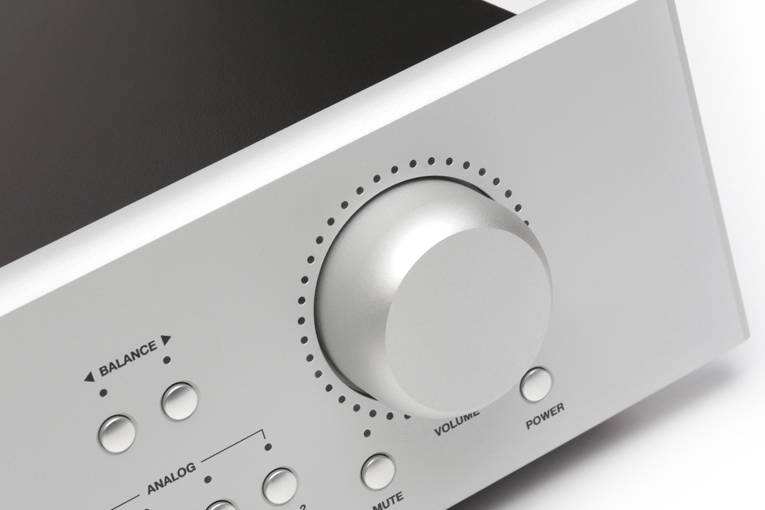
Regardless of the material, and no matter the volume or my mood, the BR-20 absolutely nailed it sonically every time I sat down for a listen. I find it astonishing to think about how difficult it must be to pare so much grunge away from an electrical signal while still providing a clear electrical pathway for the signal. To accomplish this while also making the sound musically satisfying is rare, in my experience. To achieve all that in a single chassis that can replace three components at a fair price is a huge accomplishment.
Maybe you’ve guessed the end of this story: I enjoyed the BR-20 so much that I bought the review sample. Here’s an interesting bit of irony—instead of having four Bryston components in my reference system, I now have just two.
. . . Evan McCosham
evanm@soundstagenetwork.com
Note: for the full suite of measurements from the SoundStage! Audio-Electronics Lab, click here.
Associated Equipment
- Speakers: Dynaudio Contour S5.4 with IsoAcoustics Gaia II isolation feet.
- Preamplifier: Bryston BP-25 with MPS-1 outboard power supply.
- Power amplifier: Bryston 3B SST2.
- Digital-to-analog converter: Bryston BDA-2.
- Streamer and computer: Bryston BDP-1 streamer, Apple iMac 27″ (late 2012) running Roon.
- Digital links: SignalCable balanced XLR (AES/EBU).
- Analog interconnects: AudioQuest Red River XLR, SignalCable XLR.
- Speaker cables: SignalCable 10AWG with banana plugs.
- Power cords: Pangea Audio AC-14SE, SignalCable Magic.
- Power conditioner: Torus RM15+ power isolation transformer.
- Room treatments: Vicoustic Multifuser DC2 diffusers, homemade absorption panels.
Bryston BR-20 Streaming DAC–Preamplifier
Price: $6795 without HDMI board, $7500 with HDMI board.
Warranty: Five years, parts and labor.
Bryston Ltd.
677 Neal Drive
Peterborough, Ontario K9J 6X7
Canada
Phone: (800) 632-8217, (705) 742-5325
Fax: (705) 742-0882
Website: www.bryston.com






















